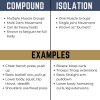Is it fine to train using low reps exclusively? Yes.
Is it optimal? No.
Great Point
The research data on the effectiveness of increasing Maximum Strength by performing Hypertrophy Training with a program that include is in Post 9.
With that said, let's look at...
Dr Michael Zouros' Research
Zourdos is a Powerlifter. His research examined how Maximum Strength is enhanced with...
Conjugate Training
This means employing different type of Strength Training into the same Periodization Training Cycle with...
1) Monday: Hypertrophy Training
2) Wednesday: Power Training
3) Friday: Maximum Strength Training
Combining these different Strength into a Periodization Cycle produced a...
The Synergistic Effect
"The sum is greater than its parts".
This meaning that the development of one type of Strength enhanced the other.
In plain English, it amount to adding 2 plus 2 and getting 5!
Block Training
Block Training revolves around Periodization Training Cycles that specifically focus on training one Strength at a time; which is effective.
Periodization Block Training Cycle
1) General Physical Preparation
2) Hypertrophy Training
3) Power Training
4) Maximum Strength Training
Dr Brad Schoenfeld's Hypertrophy Training Research
Schoenfeld determined incorporating different type into Hypertrophy Training optimized Hypertrophy.
1) Mechanical Tension
This is Maximum Strength Training.
2) Metabolic Stress
This is Bodybuilding/Hypertrophy Training.
3) Muscle Damage
InFrequently, pushing an exercise to failure or near to it. This occurs in the last week of a Periodization Training Cycle.
Also, Loaded Stretches produce Muscle Damage; Full Range Resistance Movement that Stretch Muscle in the movement; Dumbbell Bench Press that allows a greater stretch in the bottom part of the exercise, Full Squat, Pull Ups that stretch the muscle in the hang position, etc.
How the Training Program is written and followed determines which Strength is enhanced.
But my goal is actually very specific
I wanna be very strong all while keeping my weight low,
Diet
The key to maintaining, losing or gaining weight is Calorie Intake. Thus...
1) Maintaining Weight is about consuming the number of calories that keeps your weight the same.
2) Gaining Weight means consuming more calorie than you are using.
3) Losing Weight mean burning more calories than you consume.
I wanna weigh around 150 to 160 pounds and have a powerlifting total of 1000 pounds,
Doable
That is doable.
i can be mobile and light to do other sports
Being Light
Being light doesn't necessarily make you more mobile.
Olympic Lifter are the second rated highest group of most flexible and mobile athletes in sports; behind Gymnast.
It primarily has to do with an Olympic Lifter's Training Program.
Didzbalis celebrates bronze with back-flip
94 kg/207 lb Weight Class
This is so i can...also to impress people who are bigger than me by lifting more than them.
Not Likely
The reason there are Weight Classes in many sports is that with weight gain, there is an increase in Maximum Strength with knowledgeable, dedicated individuals.
Weight Class Records
Weight Class Record are usually different in each weight division. That because Heavier Lifters have more muscle mass. Thus, they more weight and the Weight Records are higher.
Every now and then there is an exception such as Eddie Coan (a genetic freak) who is considered the greatest Powerlifting of all time.
Summary
Is it fine to train using low reps exclusively? Yes.
Is it optimal? No.

